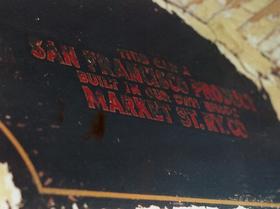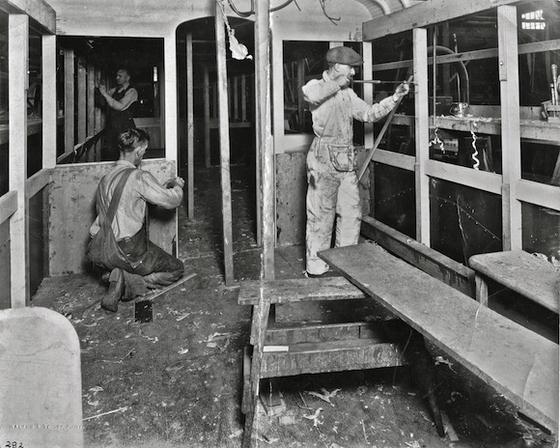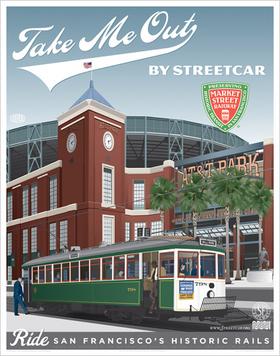An article on BART’s new cars stirred up a hornet’s nest of comments lamenting that we don’t build anything here any more — specifically transit vehicles. We’re not going to wade into that discussion (but feel free to clink the link and comment there). Coincidentally, though, that news story appeared the same day a reader in Idaho, Noel Anthony Cimino, submitted this photograph to us for publication. Here’s what he wrote:
> “This is a photo of my dad, Joseph L. Cimino, working on constructing a Market Street Railway Streetcar in the late 1920s. He’s standing to the right in the photo. It looks like he’s attaching the buzzer button that was used to announce to the carman that you wished to get off at the next stop. This photo was taken at the Elkton shops located at Ocean and San Jose Avenues.”
As some of our readers know, Muni’s old private competitor, for whom our non-profit is named, built 250 streetcars at the old Elkton Shops, using its own workforce. (For its part, Muni bought dozens of streetcars from companies who built them in San Francisco — Holman (1912-13) and Bethlehem Steel (1923).
We can’t tell which of Market Street Railway’s streetcars Mr. Cimino and his fellow craftsmen were working on. If it was the late 1920s, it wasn’t No. 798, which was built in 1924. No. 798 is the sole survivor of this “streetcar factory,” which employed many San Franciscans in good jobs for years (just as Elkton’s successor, Muni’s Curtis E. Green Light Rail Facility, does at that same location today). Both our non-profit and Muni have spent a lot of time bringing No. 798 back from the dead after it was rescued from destruction in the 1980s.
There’s still considerable electrical and mechanical work to be done on No. 798, but when it’s finished, this large, high-capacity double-ended streetcar will be one of the workhorses of the fleet — perfect for hauling crowds to and from Giants’ games, as well as carrying passengers in daily service on the E- and F-lines for decades to come. We portray No. 798’s future in our exclusive historic travel series image (available as a poster, matted print, notecard, or magnet online or at our San Francisco Railway Museum).
At the museum, you can also see a miniature streetcar of this class hand-built by the same Elkton Shops crafts workers who built the real things. Mr. Cimino may have even had a hand in that model. Surrounding the model, you can view a photo display telling the story of the old Elkton Shops and other operations of our namesake, Muni’s erstwhile privately owned competitor.

All cars built at Elkton Shops proudly wore this decal, preserved here on sole survivor No. 798: "This Car a San Francisco Product, Built in Our Own Shops. Market St. Ry. Co."
We’re all about preserving historic transit in San Francisco. We help Muni do that, but we’re not part of Muni, nor do we receive any government funding for our efforts. We count on memberships and donations. If you join our organization now, you’ll receive the new issue of our member newsletter, Inside Track, with its exclusive series on the history of America’s first public transit system — Muni — in this, its centennial year. And we’ll send you the last issue as well, with the first installment of that series. We appreciate your help in keeping vintage streetcars and cable cars as a vibrant part of the San Francisco scene.


I was just looking at some of the photos of the Elkton Street workshop (part of that Museum exhibit with the model streetcar) and noticed, in the picture, there’s a little cat sitting and watching the workmen pouring molten metal!
I was just looking at some of the photos of the Elkton Street workshop (part of that Museum exhibit with the model streetcar) and noticed, in the picture, there’s a little cat sitting and watching the workmen pouring molten metal!
I would guess that shopcats were a long-standing tradition at Elkton. I have a photo from about 1970 showing a kitty snoozing in a workman’s toolbox in the carpenter shop, where the cable cars were rebuilt. She was a “tortie/calico” cat and I was told that her name was “Rainbow”. Some years later, I was on a tour of the then-new cable car shop, and asked about Rainbow. I was assured that one of the workers had taken her home and she was now a housecat.